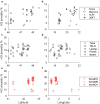Parallel palaeogenomic transects reveal complex genetic history of early European farmers
- PMID: 29144465
- PMCID: PMC5973800
- DOI: 10.1038/nature24476
Parallel palaeogenomic transects reveal complex genetic history of early European farmers
Abstract
Ancient DNA studies have established that Neolithic European populations were descended from Anatolian migrants who received a limited amount of admixture from resident hunter-gatherers. Many open questions remain, however, about the spatial and temporal dynamics of population interactions and admixture during the Neolithic period. Here we investigate the population dynamics of Neolithization across Europe using a high-resolution genome-wide ancient DNA dataset with a total of 180 samples, of which 130 are newly reported here, from the Neolithic and Chalcolithic periods of Hungary (6000-2900 bc, n = 100), Germany (5500-3000 bc, n = 42) and Spain (5500-2200 bc, n = 38). We find that genetic diversity was shaped predominantly by local processes, with varied sources and proportions of hunter-gatherer ancestry among the three regions and through time. Admixture between groups with different ancestry profiles was pervasive and resulted in observable population transformation across almost all cultural transitions. Our results shed new light on the ways in which gene flow reshaped European populations throughout the Neolithic period and demonstrate the potential of time-series-based sampling and modelling approaches to elucidate multiple dimensions of historical population interactions.
Conflict of interest statement
The authors declare no competing financial interests.
Figures








Similar articles
-
Ancient genomes link early farmers from Atapuerca in Spain to modern-day Basques.Proc Natl Acad Sci U S A. 2015 Sep 22;112(38):11917-22. doi: 10.1073/pnas.1509851112. Epub 2015 Sep 8. Proc Natl Acad Sci U S A. 2015. PMID: 26351665 Free PMC article.
-
Archaeogenomic analysis of the first steps of Neolithization in Anatolia and the Aegean.Proc Biol Sci. 2017 Nov 29;284(1867):20172064. doi: 10.1098/rspb.2017.2064. Proc Biol Sci. 2017. PMID: 29167366 Free PMC article.
-
Extensive Farming in Estonia Started through a Sex-Biased Migration from the Steppe.Curr Biol. 2017 Jul 24;27(14):2185-2193.e6. doi: 10.1016/j.cub.2017.06.022. Epub 2017 Jul 14. Curr Biol. 2017. PMID: 28712569
-
Where Asia meets Europe - recent insights from ancient human genomics.Ann Hum Biol. 2021 May;48(3):191-202. doi: 10.1080/03014460.2021.1949039. Ann Hum Biol. 2021. PMID: 34459345 Review.
-
Human genomic diversity in Europe: a summary of recent research and prospects for the future.Eur J Hum Genet. 1993;1(1):3-18. doi: 10.1159/000472383. Eur J Hum Genet. 1993. PMID: 7520820 Review.
Cited by
-
Dual ancestries and ecologies of the Late Glacial Palaeolithic in Britain.Nat Ecol Evol. 2022 Nov;6(11):1658-1668. doi: 10.1038/s41559-022-01883-z. Epub 2022 Oct 24. Nat Ecol Evol. 2022. PMID: 36280785 Free PMC article.
-
First Bronze Age Human Mitogenomes from Calabria (Grotta Della Monaca, Southern Italy).Genes (Basel). 2021 Apr 25;12(5):636. doi: 10.3390/genes12050636. Genes (Basel). 2021. PMID: 33922908 Free PMC article.
-
A 23,000-year-old southern Iberian individual links human groups that lived in Western Europe before and after the Last Glacial Maximum.Nat Ecol Evol. 2023 Apr;7(4):597-609. doi: 10.1038/s41559-023-01987-0. Epub 2023 Mar 1. Nat Ecol Evol. 2023. PMID: 36859553 Free PMC article.
-
Tracing genetic connections of ancient Hungarians to the 6th-14th century populations of the Volga-Ural region.Hum Mol Genet. 2022 Sep 29;31(19):3266-3280. doi: 10.1093/hmg/ddac106. Hum Mol Genet. 2022. PMID: 35531973 Free PMC article.
-
Genetic contributions to variation in human stature in prehistoric Europe.Proc Natl Acad Sci U S A. 2019 Oct 22;116(43):21484-21492. doi: 10.1073/pnas.1910606116. Epub 2019 Oct 8. Proc Natl Acad Sci U S A. 2019. PMID: 31594846 Free PMC article.
References
Publication types
MeSH terms
Substances
Grants and funding
LinkOut - more resources
Full Text Sources
Other Literature Sources

